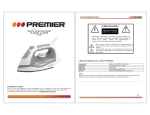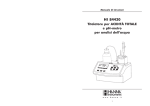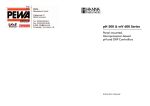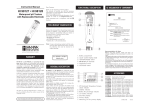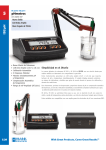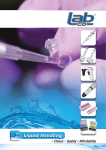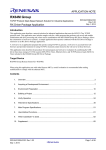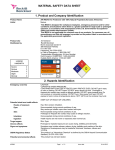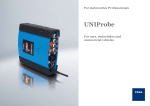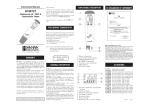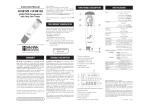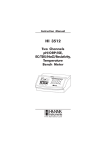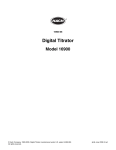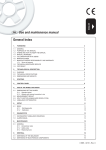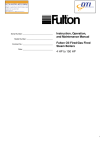Download HI 84442 - Hanna Instruments
Transcript
Instruction Manual HI 84442 TOTAL ALKALINITY FOR VERY LOW RANGE MINITITRATOR & pH METER for Water Analysis w w w. h a n n a i n s t . c o m 1 Dear Customer, Thank you for choosing a Hanna product. This manual will provide you with the necessary information for the correct use of the instrument. Please read it carefully before using the meter. If you need additional technical information, do not hesitate to e-mail us at [email protected]. This instrument is in compliance with directives. TABLE OF CONTENTS PRELIMINARY EXAMINATION................................................................................................. 3 GENERAL DESCRIPTION ........................................................................................................ 3 SPECIFICATIONS ................................................................................................................... 6 PRINCIPLE OF OPERATION .................................................................................................... 7 FUNCTIONAL AND PHYSICAL DESCRIPTION ............................................................................. 8 TITRATOR STARTUP ........................................................................................................... 10 SETUP CONFIGURATION MENU .......................................................................................... 11 ELECTRODE PREPARATION .................................................................................................. 15 ELECTRODE CALIBRATION PROCEDURE................................................................................. 16 pH BUFFER TEMPERATURE DEPENDENCE ............................................................................ 20 TITRANT PREPARATION ...................................................................................................... 20 PUMP TUBE INSTALLATION ................................................................................................. 21 PURGE .............................................................................................................................. 21 PUMP CALIBRATION PROCEDURE ........................................................................................ 23 TITRATION PROCEDURE ..................................................................................................... 25 pH MEASUREMENT ............................................................................................................ 30 TEMPERATURE CALIBRATION PROCEDURE (for technical personnel only) ............................... 34 TROUBLESHOOTING GUIDE ................................................................................................ 36 ELECTRODE CONDITIONING & MAINTENANCE ...................................................................... 37 ACCESSORIES ..................................................................................................................... 38 WARRANTY ........................................................................................................................ 39 All rights are reserved. Reproduction in whole or in part is prohibited without the written consent of the copyright owner, Hanna Instruments Inc., Woonsocket, Rhode Island, 02895, USA. 2 PRELIMINARY EXAMINATION Please examine this product carefully. Make sure that the instrument is not damaged. If any damage occurred during shipment, please notify your Dealer. Each HI 84442 minititrator is supplied complete with: • HI 1131B pH electrode • HI 7071S Filling solution (30 mL) • HI 7662-M Temperature probe • HI 84442-50 Titrant Stock solution (100 mL) (must be diluted before use) • HI 84442-55 Pump calibration solution (100 mL) • HI 7061M Cleaning solution (230 mL) • HI 7004M pH 4.01 buffer solution (230 mL) • HI 70083M pH 8.30 buffer solution (230 mL) • HI 7010M pH 10.01 buffer solution (230 mL) • Two 100 mL beakers • 100 mL white bottle • Tube set with dispensing tip • Stir bars (medium 2 pcs.) • 12 Vdc power adapter • Instruction manual Notes:• The titrant used during titrations is obtained from HI 84442-50 Titrant Stock Solution by dilution in 1:10 ratio (v/v) (see the Titrant Preparation procedure) • Save all packing material until you are sure that the instrument works correctly. Any defective item must be returned in its original packing. GENERAL DESCRIPTION The HI 84442 is an easy to use microprocessor-based automatic minititrator and pH meter designed for rapid and accurate analysis of total very low alkalinity in water. By eliminating subjective factors including color indicators, errors in mathematical calculations or erratic titrant additions from the measurement, the HI 84442 makes Total Titratable alkalinity analysis precisely. This will quickly become a valuable alkalinity analysis tool of waters. The instrument benefits from Hanna’s many years of experience as manufacturer of quality analytical instruments. A clear and well-designed user interface makes the instrument intuitive and simple to use. A dedicated HELP key aids in set-up, calibration, status and troubleshooting. By simply pressing the START key, the HI 84442 automatically starts pump operation and titrates the sample to the end point. The HI 84442 has a simple and accurate peristaltic pump to ensure the best accuracy and repeatability. By performing pump calibration with the Hanna standard provided, 3 the instrument accuracy is assured. The instrument employs a powerful and effective built-in algorithm to analyze the pH response to determine the exact pH endpoint, then uses this to make the necessary calculations. The Titratable Alkalinity determination is instantaneously displayed in selected measurement units on the large dot matrix display. The instrument is ready for the next analysis immediately. Other features: • Log on demand up to 100 samples (50 for pH measurement; 50 for titration results) • GLP feature, to view last calibration data for pH electrode and pump MEASUREMENT SIGNIFICANCE Water alkalinity is expression of a waters acid-neutralizing capacity and it is determined by titration with standard acid solutions. Alkalinity is an important parameter for control and treatment of potable and wastewaters, because it indicates the water buffering capacity (ability to resist at pH change, primarily because of bicarbonate/ carbonate content). A low water alkalinity signifies that the water is susceptible to pH change and high alkalinity indicates that water is able to resist a major change of pH. Alkalinity can be used to estimate water hardness or to determine water corrosive capacity. Alkalinity of surface water, quantified by mg/L as CaCO3 or meq/L, may be caused by carbonate, bicarbonate, hydroxide, phosphates, borates, silicates or organic acids salts. Conventionally, the water alkalinity is approximated as sum of components. Three types of alkalinities exist together to form total alkalinity: TA = OH¯ + CO32¯ + HCO3¯ OH¯ – hydroxide alkalinity CO32¯ – carbonate alkalinity HCO3¯ – bicarbonate alkalinity TA – total alkalinity Total alkalinity of water is determined by titration with an acid solution at fixed 4.5 pH value. 4 Potentiometric end point detection using a pH electrode is more objective than using visual end point determinations with color changing indicators. The HI 84442 minititrator is a potentiometric titrator. The instrument also can be used as a pH meter. The volume of titrant dispensed necessary to reach the end point is then used to calculate the water alkalinity expressed in mg/L as CaCO3 meq/L as CaCO3. Interferences: • dissolved gases, lost or gained during samples storage or transport can modify the alkalinity of the samples; • presence in the samples of the: precipitates, solid suspensions, oils, soaps can coat a pH electrode; To eliminate or diminish the interference effects, it is recommended: • to protect the samples against the atmospheric action (store in an airtight vessel); • to avoid vigorous shaking or mixing: stir gently; • maintenance of the pH electrode (see section Electrode Conditioning and Maintenance) 5 SPECIFICATIONS Titrator Range Titratable alkalinity: mg/L : 3.00 - 10.00 mg/L as CaCO3 meq/L : 0.06 - 0.20 meq/L as CaCO3 Resolution Titratable alkalinity: 0.01 mg/L 0.01 meq/L Accuracy 5% of reading Titration method Acid-base titration Principle End point titration: 4.50 pH Pump debit 0.5 mL/min Stirring speed 700 rpm Log data Up to 50 samples pH meter pH meter -2.0 to 16.0 pH / -2.00 to 16.00 pH pH Resolution: 0.1 pH / 0.01 pH pH Accuracy: ± 0.01 pH pH Calibration: 1, 2 or 3 calibration points; 3 available buffers (4.01; 8.30; 10.01) Temperature manual or automatic from compensation: -20 to 120 °C (-4 to 248 °F) Log data Up to 50 samples Temperature Range -20.0 to 120.0 °C (-4.0 to 248.0 °F) Resolution 0.1 °C Accuracy ±0.4 °C without probe error Electrode HI 1131B (included) Temperature Probe HI 7662-M (included) Environment 0 to 50 °C (32 to 122 °F); max 95% RH non-condensing Power supply 12 Vdc power adapter Dimensions 208 × 214 × 163 mm (8.2×8.4×6.4”) (with beaker) Weight 2200 g (77 oz.) 6 REQUIRED REAGENTS Code HI 84442 - 50 HI 84442 - 55 Description Titrant Pump Calibration Solution Quantity/Test 1 mL 1 mL PRINCIPLE OF OPERATION Water alkalinity determination is performed by titration with acid reagent to pH end point. Alkalinity is expressed as: • Total alkalinity determination by titration at 4.5 pH (following the reactions): If sample ph > 8.3 pH, then: 2HO¯ + H2SO4 → 2H2O + SO42¯ 2CO32¯ + H2SO4 → 2HCO3 + SO42¯ Otherwise: 2HCO3¯ + H2SO4 → 2H2CO3 + SO42¯ It is important that the samples are protected against atmospheric factors (store them in sealed bottles that are completely filled) and avoid vigorous shaking, mixing and long exposure to air. The HI 84442 minititrator is designed to determine the potentiometric titration in a very low range (mg/mL as CaCO3). HI 84442-55 is used for pump calibration. Titratable Alkalinity in waters, as performed on the HI 84442 minititrator, utilizes a simple sample preparation, a high quality peristaltic dosing pump for titrant, potentiometric endpoint detector and instantaneaous computations. To maintain the high precision of the titrator, a simple pump calibration procedure is required. The calibration involves the analysis of a known volume of a known solution (standard provided) and compensate for changes in pump dosing that may occur due to many factors including tube stretching or aging. This procedure should be performed regularly. Note: To ensure the titrant concentration stability, the HI 84442-50 titrant stock solution is 10 times more concentrated than used during titrations. Pay attention to dilute titrant in 1:10 ratio (v/v) before use. 7 FUNCTIONAL AND PHYSICAL DESCRIPTION OVERHEAD VIEW 1. 2. 3. 4. Titrant bottle Graphic LCD Keypad Dedicated guide tube for Temperature Probe 5. Electrode holder 6. Dedicated guide tube for titrant tip 7. Peristaltic pump tube FRONT VIEW REAR VIEW 8. Temperature probe 9. pH Electrode 10. Beaker 11. BNC electrode connector 12. Temperature probe socket 13. Power switch 14. Power adapter connector 15. Peristaltic pump 8 KEYPAD FUNCTION AND INDICATORS - used to leave the current screen and to return either to the previous screen or to the main screen. When pressed while modifying a parameter within the SETUP menu, exits parameter without changing it. / - used to modify the parameters’ values, to scroll the information displayed while viewing a help or to move between the options from the instrument’s SETUP HELP - used to access/leave the instrument’s contextual help MENU - used to enter SETUP, Recall or GLP selection menu, while instrument is in pH or Titration main screen STIR - used to start/stop the stirrer. Note: The stirer starts automatically during pump calibration and titration and cannot be stopped by pressing STIR key. ESC GUIDE TO INDICATORS During the instrument’s operation information is displayed on the LCD. Displayed icons: Pump running. Unstable reading. Stirrer on. Parameter can be changed. 1 9 2 8 3 4 7 5 6 1. Current time and instrument mode information (pH meter or Titrator) 2. pH electrode condition information 3. Main reading information 4. Instrument status information 9 5. Functional key area 6. Indicates that the displayed value can be changed using ARROW keys 7. Temperature value (°C, °F) 8. pH temperature compensation mode (Manual or Automatic) 9. Stirrer and reading status area PERISTALTIC PUMP Peristaltic pumps are self priming. Liquid never contacts the pump components. The titrant tubing is pressed along the rotating rollers of the pump. The rollers compress the tubing, driving the titrant to the dispensing tip. TITRATOR STARTUP This is a general outline of the steps required to make a titration. The following sections expand upon each section. • Place the instrument on a flat table. Do not place the instrument in direct sun light. • Connect the power adapter to the instrument. • Turn the instrument ON using the power switch from the rear panel of the instrument. • Set up the instrument. See the “Setup Configuration Menu” section for details. • Connect the pH sensor and temperature probe to the instrument. • Calibrate the pH electrode. At least a single point calibration is necessary for titration. • Place the peristaltic pump tube on the pump (inlet tube is connected with the reagent bottle, outlet tube is connected with the dosing tip). See the “Pump Tube Replacement” section for the procedure. • Remove the reagent bottle cap and replace the bottle cap with the tubes. Place the reagent bottle in the appropriate place on the titrator top. • Purge the titrant. • Calibrate the pump. • Prepare the sample. • Run a titration and log sample results. 10 SETUP CONFIGURATION MENU The titrator’s setup configuration menu may be accessed from the pH or titration screens by pressing the MENU key, then Setup. A list of setup parameters will be displayed with currently configured setting. While in the setup menu it is possible to modify the instrument’s operation parameters. The ARROW keys permit the user to scroll the setup parameters. Press HELP to view the contextual help. Press ESC to return to the main screen. Concentration unit Options: mg/L, meq/L. Press the corresponding function key to change the option. Calibration timeout Options: Disabled or 1 to 7 days. This option is used to set the number of days before the pH calibration expired warning message is flagged. Press Modify to access the calibration timeout value modify parameter. Use the ARROW keys in order to increase/decrease the value. Press Accept to confirm or ESC to return to the setup menu without saving the new value. pH resolution Options: 0.1, 0.01. Press the displayed function key in order to change the pH resolution. 11 Temperature unit Options: °C, °F. Press the function key in order to change the temperature unit. Backlight Options: 0 to 8. Press Modify to access the backlight level. / in order to Use the ARROW keys or increase/decrease the displayed constrast. Press Accept to confirm or ESC to return to the setup menu. Contrast Option: 0 to 20. This option is used to set the display’s contrast. Press Modify to change the display’s contrast. Use the ARROW keys or / in order to increase/decrease the value. Press Accept to confirm the value or ESC to return to the setup menu. 12 Date / Time This option is used to set the instrument’s date and time. Press Modify to change the date/time. Press / to highlight the value to be modified (year, month, day, hour, minute or second). Use the ARROW keys to change the value. Press Accept to confirm the new value or ESC to return to the setup. Time format Option: AM/PM or 24 hours. Press the functional key to select the new value. Date format Press Modify to change the Date Format. Use the ARROW keys to select the desired format. Press Accept to confirm the value or ESC to return to the setup menu. 13 Language Press the corresponding function key to change the language. If the new selected language cannot be loaded, the previously selected language will be reloaded. Tutorial If no language can be loaded at startup the instrument will work in the “safe mode”. In “safe mode” all the messages are displayed in English and tutorial and help information are not available. This option is used to enable/disable tutorial mode. If enabled this option will provide the user short guides on the screen. Press the function key to select this option. Beep On Meter information Press the function key to select the new option. When enabled, a short beep is heard every time a key is pressed or when the calibration can be confirmed. A long beep alert sounds when the pressed key is not active or a wrong condition is detected while in calibration. Press Select to view the firmware version, language version, mV factory calibration date and time and temperature factory calibration date and time. Press ESC to return to the Setup mode. 14 ELECTRODE PREPARATION PREPARATION PROCEDURE Remove the electrode protective cap. DO NOT BE ALARMED IF ANY SALT DEPOSITS ARE PRESENT. This is normal with electrodes and they will disappear when rinsed with distilled water. During transport tiny bubbles of air may have formed inside the glass bulb. The electrode cannot function properly under these conditions. These bubbles can be removed by "shaking down" the electrode as you would do with a glass thermometer. If the bulb is dry, soak the electrode in HI 70300 Storage Solution for at least one hour. 15 ELECTRODE CALIBRATION PROCEDURE It is recommended to calibrate the instrument frequently, especially if high accuracy is required. The pH electrode should be recalibrated: a) Whenever the pH electrode is replaced b) At least once a week c) After testing aggressive chemicals and after electrode is cleaned d) When high accuracy is required e) If the pH calibration expired warning is displayed during measurement. Every time you calibrate the instrument clean the electrode (see the “pH Cleaning Procedure” section) and use fresh buffers. PROCEDURE A single, two or three-points calibration can be performed, using the three predefined buffers 4.01, 8.30 and 10.01 pH. For a single point calibration any of the three buffers may be used, but using 4.01 pH is recommended. Note: The HI 84442 will not accept other pH buffers for calibration. • Pour small quantities of selected buffer solutions into clean beakers. For accurate calibration use two beakers for each buffer solution, the first one for rinsing the electrode and the second one for calibration. • Put a magnetic stir bar in each beaker with the calibration buffer solution. • Remove the protective cap and rinse the electrodes with some of the buffer solution to be used for the first calibration point. Open fill hole on electrode. • Put the first beaker with calibration buffer in the beaker holder. • Place the electrode holder on the top of the beaker and secure it by turning clockwise. • Immerse the pH electrode and the temperature probe approximately 2 cm (0.8”) into the buffer paying attention not to touch the stir bar. To select Electrode calibration screen follow the next steps: • From pH meter screen press CAL function key then Electrode. • From Titrator screen press CAL function key then Electrode. • The electrode calibration screen will be displayed. Point 1 calibration • The 4.01 buffer will be selected by default. If necessary press the ARROW keys in order to select a different buffer value. 16 • The (unstable measurement) symbol will be shown on the display until the reading becomes stable. • When the reading is stable and close to the selected buffer, the (unstable measurement) symbol will disappear and the Confirm key will become active. • Press Confirm to confirm the calibration. • Press ESC to exit calibration. Notes:• To clear a previous calibration and to return to the default value, press Clear at any time after entering calibration mode. The “Calibration cleared” message will be shown for a few seconds on the display. If Clear is invoked during the first calibration point the instrument returns to the measurement mode. • The Clear key is displayed only if a previous calibration exists. Point 2 calibration • The calibrated value will be shown on the display and the second expected buffer value will be displayed. • Remove the electrode holder with electrodes from the top of the beaker. • Place the second buffer into beaker and place in beaker holder. Rinse the electrodes in a beaker containing the second buffer rinsing solution. • Place the electrode holder (with electrodes) on the top of the beaker, lock cap by turning. • If necessary press the ARROW keys in order to select a different buffer value. • The (unstable measurement) symbol will be shown on the display until the reading becomes stable. • When the reading is stable and close to the selected buffer, the (unstable measurement) symbol will disappear and the Confirm key will become active. • Press Confirm to confirm the calibration. 17 • The calibrated value will be shown on the display and the third expected buffer value will be automatically selected. • After the second calibration point has been confirmed, press ESC to exit without performing the third calibration point. Point 3 calibration • Remove the electrode holder with electrodes from the top of the beaker. • Place the third buffer solution in a beaker and place in beaker holder. Rinse the probes in a beaker with third buffer rinsing solution. • Place the electrode holder (with electrode) in the beaker with third buffer and secure top by locking. • The (unstable measurement) symbol will be shown on the display until the reading becomes stable. • When the reading is stable and close to the selected buffer, the (unstable measurement) symbol will disappear and the Confirm key will become active. • Press Confirm to confirm the calibration. The instrument stores the calibration value and returns to pH meter/titrator calibration menu, where the date and time for the last pH calibration will be displayed. Notes:• A buffer confirmed during the calibration process is removed from the list of calibration buffers available for further calibration points. • If the value measured by the instrument is not close to the selected buffer a “Wrong Buffer” error message will be shown on the display. Check if the correct buffer has been used or regenerate the pH electrodes by following the Cleaning Procedure (see the “pH Cleaning Procedure” section). If necessary change the buffer or the electrode. 18 • If the measured offset isn’t within the preset limits the meter will display the message “Buffer Contaminated” alternatively with ”Electrode Dirty/Broken”. • If the computed slope isn’t within the preset limits the meter will display the message “Wrong Slope”. If the slope is too high the symbol will be displayed. If the will be displayed. slope is too low the symbol • If the “Wrong Old Slope” error message is displayed, an inconsistency exists between the current and the previous (old) calibration. Clear the calibration parameters by pressing Clear and proceed with calibration from the current calibration point. The instrument will keep all the confirmed values during the current calibration point. • If the temperature reading is out of the defined temperature range of the buffer (0 to 45 °C) the “Wrong Buffer Temperature” error message will be displayed, and the symbol °C will blink on the display. Calibration cannot be confirmed in this situation. 19 pH BUFFER TEMPERATURE DEPENDENCE The temperature has an effect on pH. The calibration buffer solutions are affected by temperature changes to a lesser degree than normal solutions. During calibration the instrument will automatically calibrate to the pH value corresponding to the measured or set temperature. During calibration the instrument will display the pH buffer value at 25 °C. TEMP pH BUFFERS °C °F 4. 01 8. 30 10. 01 0 32 4.01 8.48 10.32 5 41 4.00 8.44 10.24 10 50 4.00 8.41 10.18 15 59 4.00 8.37 10.12 20 68 4.00 8.33 10.06 25 77 4.01 8.30 10.01 30 86 4.02 8.27 9.96 35 95 4.03 8.24 9.92 40 104 4.04 8.21 9.88 TITRANT PREPARATION - Take 10 mL HI 84442-50 titrant solution (accurate measured) and add to the clean 100 mL white bottle. - Add 90 mL of distilled water. - Mix carefully. Use new obtained titrant on the further titrations. 20 PUMP TUBE INSTALLATION To mount the new peristaltic pump tube follow next steps: • Position one peristaltic pump fixing ring on its location. • Stretch the tube over the peristaltic pump rolls. • Fix the second pump fixing ring on its location. • Attach the tube to the reagent bottle. Note: Purge the peristaltic pump until drops of reagent appears on the dosing tip by pressing the PURGE key from the titrator main screen. To remove the tube of the peristaltic pump follow next steps: Caution: Purge line with water to remove titrant solution from tube. • Detach the tubes system from the reagent bottle. • Grasp one fixing ring of the peristaltic pump tube. • Pull the tube until the fixing rings are taken out from their location. • Remove the other side of the tube. PURGE Purging should be performed: • whenever the tube of the peristaltic pump is replaced; • whenever the titrant is changed or a new bottle is used; • before starting a pump calibration; • before starting a lot of titrations. In order to start purging press the Purge key from the titrator main screen. The purging stops automatically after 5 minutes. To access the Purge key follow the next steps: • From the instrument main screen (pH meter screen) press “Titrator” function key. The instrument will display the next screen if any of the following conditions exist: - the meter hasn’t been calibrated in 4.01 pH buffer - the pH calibration has expired - a pump calibration hasn’t been performed or more than 3 days have passed since the last pump calibration 21 Press CAL to access the titration calibration menu where electrode and pump calibration may be accessed. Press HELP to view the contextual help. • Press Continue or ESC to skip the message and enter Titrator main screen. • Press Purge to begin a purge cycle. The purging stops automatically after 5 minutes. To stop purging at any time and return to the main screen press ESC or Stop. During a purge, the remaining time until the purge process will be completed is shown on the lower right side of the display. Press Pause to interrupt the purge process. Press Pause or Stop (by pressing the corresponding function key in the purge screen) • after the first drops of fresh titrant appear at the dosing tip • in case of error conditions (empty titrant, bottle, tubes or dosing tip disconected, pump error) • if you want to resume at a later time If Pause is pressed the next screen is displayed: Press Resume to continue purging. 22 After 5 minutes purging interval has elapsed, the “Completed” message is displayed. Another purge period can be initiated by pressing Restart or press ESC to return to main titrator screen. PUMP CALIBRATION PROCEDURE The pump calibration must be performed each time the titrant bottle or the pH electrode is changed. It is recommended the pump calibration to be performed before each set of titrations. Verify: The electrode has been calibrated in 4.01 pH buffer. • Sample preparation: Add 1 mL of HI 84442-55 Pump Calibration Solution to a clean beaker. Fill the beaker up to the 75 mL mark with the distilled or deionized water. Place the stir bar into the beaker and then place the beaker into the appropriate place on the instrument top. • Place the electrode holder on the top of the beaker and secure it by turning clockwise. • Before immerse the electrodes in the beaker: - Carefully rinse the pH electrode and temperature probe with deionized water. - Dry electrodes using soft paper. - Rinse again with the deionized water. • Immerse the calibrated pH and the temperature electrodes approximatively 2 cm (0.8”) into the sample to be tested paying attention not to touch the stir bar. • Insert the dosing tip in the appropriate guide tube holder place taking care not to empty the tip. Note: The chemical reagents may be hazardous if improperly handled. Read the Material Safety Data Sheets (MSDS) before performing the test. •From the titrator main screen press CAL. 23 The instrument displays the date and time of the last electrode calibration, and the date and time of the last pump calibration, or calibration expired messages. • Press Pump. The next screen will be displayed. • Press Start. • After the pump calibration is started, on the upper right side of the display two animations will be shown in order to indicate that the pump and the stirrer are working. On the lower right side of the display is shown the amount of time that has passed since beginning of the calibration. • After the pump calibration is complete a confirmation message is displayed for a few seconds, then the instrument will return to the titrator calibration menu and will display the new time and date for the last pump calibration. Notes:• If an erroneous situation is encountered during the calibration, an error message is displayed and the calibration can be restarted by pressing Restart. 24 • If the calibration doesn’t complete within 6 minutes the error message “Too much standard” will be displayed and the calibration can be restarted by pressing Restart after a new standard is prepared. • When pump calibration is complete, carefully unscrew electrode holder with pH electrode, temperature probe and titrant top intact. Hold over rinse beaker and rinse off with distilled or deionized water. Remove beaker and rinse out. TITRATION PROCEDURE Verify: The instrument has been calibrated (pH and pump) before performing a lot of titrations. An electrode calibration in at least one point (4.01 pH buffer) is recommended. • Refer to Setup Configuration Menu (see the “Setup” section) to set up the instrument for your measurement. • Sample preparation: For all measurement samples fill a beaker up to the 75 mL mark with sample. Place the stir bar into the beaker and then place the beaker in the appropriate place on the instrument top. Note: Water samples must be collected and stored in capped botlles. • Position the electrode holder on the top of the beaker and secure it by turning clockwise. • Before immerse the electrodes in the beaker: - Carefully rinse the pH electrode and temperature probe with deionized water. - Dry electrodes using soft paper. - Rinse again with the deionized water. • Immerse the pH and the temperature electrodes approximatively 2 cm (0.8”) into the sample to be tested paying attention not to touch the stir bar. Use O-Rings provided to secure the pH electrode in holder. 25 • Insert the dosing tip in the appropriate holder place. • From the titrator main screen press Titration. To enter titrator main screen from pH meter mode press Titrator and then Continue. • Press Start to begin the titration process. • After the titration is started on the upper right side of the display two animations will be shown in order to indicate that the pump and the stirrer are running. On the lower right side of the display is shown the period of time since the titration has been started. • After the titration is complete, the concentration value is displayed in the selected unit. • Press Unit to change the display unit. • Press LOG to record the concentration value into the instrument’s memory. A message will be displayed for a few seconds indicating the amount of the free log space. 50 log samples can be recorded in the instrument’s memory. When the titrator free log space is under 12% the message will be shown permanently. • If the concentration is out of limits an exceeded range limit message will be displayed blinking and the message “Out of range” will be shown. Another titration can be initiated by pressing Restart. 26 • Remove electrode holder. Rinse the electrode into waste container. • Prepare a fresh sample and place on titrator. Place the temperature probe and the electrode in the appropriate guides. • Immerse the titrant tip and use care not to dislodge titrant from dispensing tip. Note: If the end-point is not reached or it is not recognized or the input reading is out of range, an error message will be displayed. The titration can be restarted after a new sample is prepared by pressing Restart. TIPS FOR AN ACCURATE MEASUREMENT • Calibrate the instrument in 4.01 pH buffer solution at least once a day, before you start to perform measurements. • Purge the peristaltic pump to have the fresh titrant when starting a new calibration. • Calibrate the peristaltic pump daily before performing a set of analyses. • Clean the electrode in order to remove the possible coating from bulb. • Precision of the measurement can be improved by using volumetric pipettes for standard and sample additions. VIEW/DELETE LOGGED SAMPLES Press MENU key while in Titrator main screen. Press Recall to access the titrator logged data. The instrument will display a list of all the titration records stored in the titration log. Use the ARROW keys to scroll the stored records list. If the saved concentration was out of range the “!” symbol is displayed in front of the reading. 27 Press Delete to enter delete record screen. Press Delete All to enter delete all records screen. Press More to view additional information of the measurement. Press Unit to convert the result between meq/L and mg/L. Press ESC to return to the previous screen. Use the ARROW keys when is displayed to scroll between the log records. If Delete was pressed the instrument will ask for confirmation. Use the ARROW keys to focus on the record to be deleted. Press Confirm to delete the record or ESC to return to the previous screen. Deleting a record will renumber the list of records. If Delete All was pressed the instrument will ask for confirmation. Press Confirm to delete all the records or ESC to return to the previous screen. If the titrator log is empty the message “No Records!” will be displayed. 28 TITRATOR GLP INFORMATION Press MENU while in Titration mode and then GLP. From this screen it is possible to select between viewing the electrode GLP or the pump GLP. Press GLP elec. to view the electrode’s last calibration parameters and date. Press GLP pump to view the pump’s last calibration time and date. If GLP elec. is pressed one of the next screens will be displayed. GLP contains a set of information regarding electrode calibration. The following items are included in electrode GLP: the time and date of the last calibration, offset, slope, calibration timeout and the calibration buffers. The buffers displayed in video inverse mode are from the previous calibration. If a calibration hasn’t been performed the message “Not Calibrated” will be displayed. If GLP pump is pressed, one of the next screens is displayed. 29 The pump GLP displays the Time and Date of the last pump calibration. If a calibration hasn’t been performed the message “Not Calibrated” will be displayed. pH MEASUREMENT The HI 84442 may be used as a pH meter for direct measurements. Verify that the instrument has been calibrated before taking pH measurements. Set the instrument to pH meter. At power up the instrument enter pH meter mode. From titrator mode press ESC until pH units are displayed. If an electrode calibration hasn’t been performed, or the number of days exceeds calibration timeout value set, the displayed message “CAL DUE” will blink on the left side of the display (see Calibration timeout option in Setup for details). Place pH electrode into electrode holder and connect it to the instrument. Rinse the pH tip with distilled or deionized water. Immerse the pH (bottom 2 cm / 0.8”) in the sample and stir gently for a few seconds. For a faster response and to avoid cross-contamination of the samples, rinse the electrode tip with a few drops of the solution to be tested, before taking measurements. If CAL DUE is displayed perform an electrode calibration. Press MENU to access the instrument’s menu. Press HELP to view the contextual help, every time you need supplementary information. The help is customized for every situation that can appear during instrument usage. Press STIR to start/stop the stirrer. Press Titrator to enter titrator mode. Press CAL to access the calibration menu. 30 Press LOG to memorize the current reading. A message indicating the free log space will be displayed for a few seconds. In order to take pH measurements follow the next steps: • Submerge the pH bulb 2 cm (0,8’’) and the temperature probe into the sample to be tested and stir gently. Allow time for the electrode to stabilize. When the reading becomes stable the (unstable measurement) symbol will disappear. • If the pH readings are less than -2.00 or greater than 16.00 pH the closest full-scale value (-2.00 pH or 16.00 pH) will be displayed blinking. If measurements are taken successively in different samples, it is recommended to rinse the electrodes thoroughly with deionized water or distilled water and then with some of the next sample to prevent cross-contamination. pH measurements are affected by temperature. In order to have accurate pH measurements, the temperature effect must be compensated for. To use the Automatic Temperature Compensation (ATC) feature, connect and submerge the HI 7662-M temperature probe into the sample in the dedicated guide tube and wait for a few seconds. The “ATC” message will be shown on the display. Automatic Temperature Compensation will provide pH corrected values at the temperature of measurements. If Manual Temperature Compensation (MTC) is desired, the temperature probe must be disconnected from the instrument. The default temperature of 25 °C (77 °F) or the last temperature reading will be displayed preceded by the symbol and the “MTC” message. The manually set temperature can now be adjusted with the ARROW keys (from -20.0 to 120.0 °C). 31 VIEW OR DELETE PREVIOUSLY LOGGED RECORDS Press MENU key while in pH meter screen. Press Recall to access the pH recall. A list of records is stored in the pH log. Use the ARROW keys to scroll the list of records. Press More to see detailed information about the highlighted record. Press Delete to enter record deleting mode. Press Delete All to enter all records deleting mode. If More is pressed a complete set of data is displayed. Use ARROW keys when is displayed to scroll between the records. If Delete was pressed the instrument will ask for confirmation. Use the ARROW keys to focus on the record to be deleted. Press Confirm to delete the record or ESC to return to the previous screen without deleting. 32 Deleting a record will renumber the list of records. If Delete All was pressed the instrument will ask for confirmation. Press Confirm to delete all records or ESC to return to the previous screen without deleting. If the pH log is empty the message “No Records!” will be displayed. pH METER GLP INFORMATION The pH meter GLP information references the last pH calibration data. To view this information press MENU key while in pH meter mode then GLP. A set of information regarding electrode calibration is displayed. The following items are included in electrode GLP: the time and date of the last calibration, offset, slope, electrode condition, calibration timeout and the calibration buffers. The buffers displayed in video inverse mode are from the previous calibration. If a calibration hasn’t been performed the message “Not Calibrated” will be displayed. 33 TEMPERATURE CALIBRATION PROCEDURE (for technical personnel only) All the instruments are factory calibrated for temperature. HANNA’s temperature probes are interchangeable and no temperature calibration is needed when they are replaced. If the temperature measurements are inaccurate, temperature recalibration should be performed. For an accurate recalibration, contact your dealer or the nearest HANNA Customer Service Center, or follow the instructions below. • Prepare a vessel containing ice and water and another one containing hot water (at a temperature of around 50 °C). Place insulation material around the vessels to minimize temperature changes. • Use a calibrated thermometer with a resolution of 0.1 °C as a reference. • To enter user calibration screen press and hold down the ARROW keys simultaneously, then power on the instrument. After a few seconds the User calibration screen is displayed. • Press Temp function key to enter temperature calibration. • Immerse the temperature probe in the vessel with ice and water as near as possible to the reference thermometer. Allow a few seconds for the probe to stabilize. • Use the ARROW keys to set the calibration point value to that of the ice and water measured by the reference thermometer. • The (unstable measurement) symbol will be shown on the display until the reading becomes stable. • When the reading is stable and close to the selected calibration point, the (unstable measurement) symbol will disappear and the Confirm key will become active. • Press Confirm to confirm the calibration point. • The meter will be automatically move to the second calibration point, and will display 50 °C for the buffer value. 34 • Immerse the temperature probe in the second vessel as near as possible to the reference thermometer. Allow a few seconds for the probe to stabilize. • Use the ARROW keys to set the calibration point value to that of the hot water, measured by the reference thermometer. • The (unstable measurement) symbol will be shown on the display until the reading becomes stable. • When the reading is stable and close to the selected calibration point, the (unstable measurement) symbol will disappear and the Confirm key will become active. • Press Confirm to confirm the calibration point. The instrument will return to the pH meter/ titrator main screen. Notes:• If the reading is not close to the selected calibration point, the “Wrong” message will be displayed. Change the temperature probe and restart the calibration. • If the temperature probe is disconnected or the measured temperature is out of the 20 to120 °C range the instrument will display “----”. The calibration point value can be changed using the ARROW keys. 35 TROUBLESHOOTING GUIDE SYMPTO MS PRO BLEM SO LU TI O N Slow resp onse/excessive d rift. D irty p H electrod e. Soa k the electrod e tip HI 7061 clea ning solution for 30 minutes. Refill with fill solution. Rea d ing fluctua tes up a nd d own (noise). Clog g ed /d irty junction. L ow electrolyte level (refilla b le p H electrod es only). Ca b le connection. Clea n the electrod es. Refill with fresh fill solution. Check ca b le connection to meter a nd verify p rotective ca p is removed . While in p H rea d ing mod e, -2.00 or 16.00 p H is d isp la yed b linking . Rea d ing out of ra ng e. Check ca b le connection to meter a nd verify p rotective ca p is removed . Check the q ua lity of the sa mp le. Clea n the electrod es. Refill with fresh fill solution. The meter d oes not a ccep t the p H b uffer solution for ca lib ra tion. Broken p H electrod e. Rep la ce the electrod e or conta ct the vend or. Wrong p ump ca lib ra tion solution. Broken p ump tub ing . Broken electrod es. Verify tub ing is inta ct a nd a nd titra nt p a sses when p urg ed . Verify the electrod e ha s b een ca lib ra ted recently in fresh p H b uffers. Check the p ump ca lib ra tion solution. Prep a re a nother sta nd a rd , p urg e to ha ve fresh titra nt a nd resta rt the ca lib ra tion. The p ump ca lib ra tion ca n't b e p erformed The temp era ture p rob e is Broken temp era ture connected , b ut the meter p rob e. d isp la ys "MTC". Rep la ce temp era ture p rob e. After a titra tion the instrument d isp la ys b linking . Concentra tion out of Prime a nd reca lib ra te the ra ng e. instrument (p ump ). At sta rtup the meter d isp la ys the HANNA log o p erma nently. One of the keys is b locked . Check the keyb oa rd or conta ct the vend or. ""E rror xx"" messa g e is d isp la yed . Interna l error. Power off the meter a nd then p ower it on a g a in. If the error p ersists, conta ct the vend or. 36 ELECTRODE CONDITIONING AND MAINTENANCE STORAGE PROCEDURE To assure a quick response time, the glass bulb should be kept moist and not allowed to dry out. Replace the solution in the protective cap with a few drops of HI 70300 or HI 80300 Storage Solution. Follow the Preparation Procedure section before taking measurements. Note: NEVER STORE THE pH ELECTRODE IN DISTILLED OR DEIONIZED WATER. PERIODIC MAINTENANCE Inspect the electrodes and the cables. The cable used for connection to the instrument must be intact. There should be no cracks on the electrode stem or bulb. Connectors must be perfectly clean and dry. If any scratches or cracks are present, replace the electrode. Rinse off any salt deposits with water. pH CLEANING PROCEDURE • General Soak in Hanna HI 7061 or HI 8061 General Cleaning Solution for approximately ½ hour. IMPORTANT: After performing any of the cleaning procedures, rinse the electrode thoroughly with distilled or deionized water and soak the electrode in HI 70300 or HI 80300 Storage Solution for at least 1 hour before use. Recalibrate electrode before using. 37 ACCESSORIES REAGENTS HI 84442-50 HI 84442-55 HI 84442-70 Titrant solution for low range (100mL) Pump calibration solution (100mL) Reagents kit for low and high range (about 500 titrations) pH CALIBRATION SOLUTIONS HI 7004M Buffer solution pH 4.01 (230mL) HI 70083M Buffer solution pH 8.30 (230mL) HI 7010M Buffer solution pH 10.01 (230mL) HI 7004M-6 Buffer solution pH 4.01 (6 x 230mL) HI 70083M-6 Buffer solution pH 8.30 (6 x 230mL) HI 7010M-6 Buffer solution pH 10.01 (6 x 230mL) ELECTRODES HI 1131B HI 7662-M pH Electrode Temperature probe ELECTRODE FILL SOLUTION HI 7071S Filling solution (30 mL) for HI 1131B ELECTRODE STORAGE SOLUTION HI 70300M Storage Solution, 230 mL bottle CLEANING SOLUTION HI 7061M Electrode Cleaning Solution, 230 mL bottle OTHER ACCESSORIES HI 70483M HI 731319 HI 731342 HI 731352 HI 731341 HI 731351 Tube set with cap and tip for titrant bottle Stir bar 25 x 7 mm (10 pcs) 2000μL fixed volume pipette Tip for 2000μL fixed pipette (4 pcs) 1000μL fixed volume pipette Tip for 1000μL fixed pipette (25 pcs) 38 WARRANTY HI 84442 is warranteed for two years against defects in workmanship and materials when used for its intended purpose and maintained according to the instructions. This warranty is limited to repair or replacement free of charge. Damage due to accident, misuse, tampering or lack of prescribed maintenance is not covered. If service is required, contact your dealer. If under warranty, report the model number, date of purchase, serial number and the nature of the failure. If the repair is not covered by the warranty, you will be notified of the charges incurred. If the instrument is to be returned to Hanna Instruments, first obtain a Returned Goods Authorization Number from the Customer Service Department and then send it with shipment costs prepaid. When shipping any instrument, make sure it is properly packaged for complete protection. To validate your warranty, fill out and return the enclosed warranty card within 14 days from the date of purchase. RECOMMENDATION FOR USERS Before using this product, make sure that it is entirely suitable for your specific application and for the environment in which it is used. Operation of this instrument may cause unacceptable interferences to other electronic equipments, this requiring the operator to take all necessary steps to correct interferences. Any variation introduced by the user to the supplied equipment may degrade the instrument EMC performance. To avoid damages or burns, do not put the instrument in microwave ovens. For yours and the instrument safety do not use or store the instrument in hazardous environments. Hanna Instruments reserves the right to modify the design, construction and appearance of its products without advance notice. 39 SALES AND TECHNICAL SERVICE CONTACTS Australia: Tel. (03) 9769.0666 • Fax (03) 9769.0699 China: Tel. (10) 88570068 • Fax (10) 88570060 Egypt: Tel. & Fax (02) 2758.683 Germany: Tel. (07851) 9129-0 • Fax (07851) 9129-99 Greece: Tel. (210) 823.5192 • Fax (210) 884.0210 Indonesia: Tel. (210) 4584.2941 • Fax (210) 4584.2942 Japan: Tel. (03) 3258.9565 • Fax (03) 3258.9567 Korea: Tel. (02) 2278.5147 • Fax (02) 2264.1729 Malaysia: Tel. (603) 5638.9940 • Fax (603) 5638.9829 Singapore: Tel. 6296.7118 • Fax 6291.6906 South Africa: Tel. (011) 615.6076 • Fax (011) 615.8582 Taiwan: Tel. 886.2.2739.3014 • Fax 886.2.2739.2983 Thailand: United Kingdom: Tel. (01525) 850.855 • Fax (01525) 853.668 MAN84442 01/09 Tel. 66.2619.0708 • Fax 66.2619.0061 USA: Tel. (401) 765.7500 • Fax (401) 765.7575 For e-mail contacts and a complete list of Sales and Technical offices, please see www.hannainst.com. 40








































